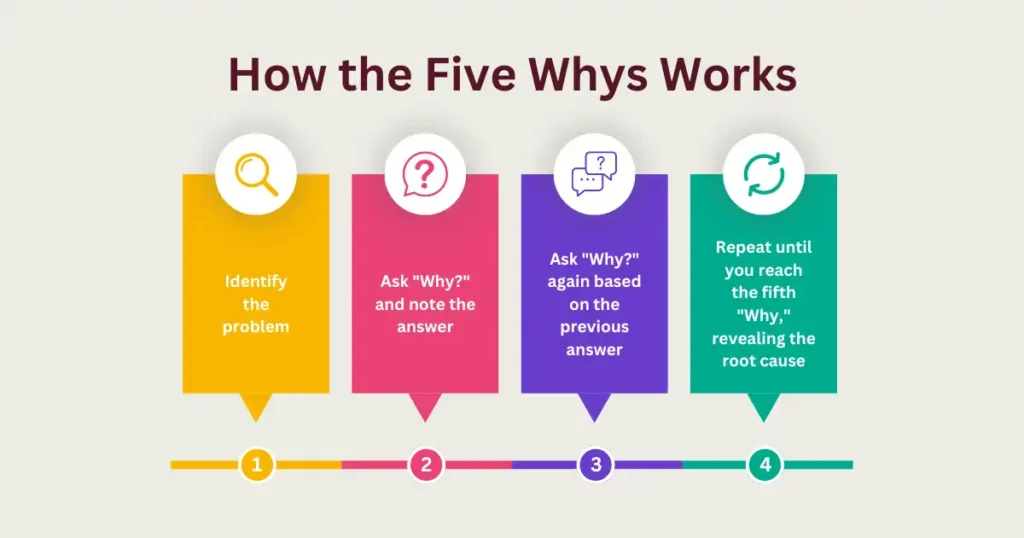Root Cause Analysis: 5 Whys Diagram | Certification Course
Buy Now for $9.99
Udemy prices may vary depending on applied coupons and promotional events.
- 🧑🏫 26 lectures
- ⌚ 2h 4m total length
- 🗃️ 4 downloadable resources
- 📜 Certificate of completion
- 👩🎓 15,663 students
- ⭐ 4.5 rating by 2,699 students
It’s not just “ask why” five times. This course teaches you how to avoid blame, how to go deep without going off track, and how to apply the method in real work scenarios.
Table of Contents
Imagine you’re running a manufacturing plant, and suddenly, one of your key machines breaks down. The team quickly jumps to fix it, but just a few days later, it breaks down again. Frustrating, right? This scenario happens all too often when we address only the symptoms of a problem rather than digging deeper to find the root cause. That’s where the “Five Whys” technique comes into play.
The “Five Whys” is a simple yet powerful tool used for root cause analysis. It involves asking the question “why?” five times (or more) to drill down into the core issue of a problem. This technique helps to peel away the layers of symptoms which can lead to the root cause of a problem.
Why is this important? Well, root cause analysis is crucial in various industries like manufacturing, healthcare, and IT. It ensures that problems are solved at their source, preventing recurring issues and saving time and resources in the long run.
History and Origin
Background: The Five Whys method traces its roots back to the early 20th century when it was developed by Sakichi Toyoda, a Japanese industrialist, inventor, and the founder of Toyota Industries. Sakichi Toyoda created this technique as part of his broader philosophy of continuous improvement, which later became a cornerstone of the Toyota Production System. The Five Whys method was adopted by Toyota as a critical component of their Lean manufacturing process. This technique helped Toyota to identify underlying issues in their production line, ultimately leading to more efficient and effective problem-solving.
Evolution: Over the years, the Five Whys method has transcended its manufacturing origins and found applications in a wide array of industries. From healthcare to IT, and beyond, organizations have embraced the Five Whys as a straightforward and effective tool for root cause analysis. Its simplicity and adaptability make it a valuable asset in any problem-solving toolkit, enabling teams across various sectors to dig deeper into issues and implement solutions that address the core problem, rather than just treating the symptoms.
How the Five Whys Works

Step-by-Step Process:
Step 1: Identify the problem.
Begin by clearly stating the problem you are facing. This might be a recurring defect in a product, a process inefficiency, or any other issue that needs resolving
Step 2: Ask “Why?” and note the answer.
Once the problem is identified, ask “Why did this problem occur?” Write down the answer as this will form the basis for the next question.
Step 3: Ask “Why?” again based on the previous answer.
Using the answer from Step 2, ask “Why did this happen?” again. This helps to drill down further into the cause of the issue.
Step 4: Repeat until you reach the fifth “Why,” revealing the root cause.
Continue this process, asking “Why?” for a total of five times, or more if necessary, until you reach the fundamental cause of the problem. The root cause is the underlying reason that, if addressed, will prevent the issue from recurring.
Example Scenario:
Let’s walk through a practical example to illustrate how the Five Whys works.
Problem: A product is frequently found to have a defect.
- Why is the product defective?
- Because the material used was substandard.
- Why was substandard material used?
- Because the supplier provided a low-quality batch.
- Why did the supplier provide a low-quality batch?
- Because the supplier did not follow the specified quality standards.
- Why did the supplier not follow the specified quality standards?
- Because there was a lack of communication of these standards to the supplier.
- Why was there a lack of communication of these standards to the supplier?
- Because the procurement team did not have a proper process for conveying quality requirements.
Root Cause: The procurement team did not have a proper process for conveying quality requirements to the supplier.
Common Pitfalls:
- Stopping Too Soon: One of the most common pitfalls is stopping the analysis too early. Sometimes, the real root cause is not evident after just a few “Whys,” and it requires persistence to uncover the true underlying issue.
- Getting Stuck on Symptoms: Another challenge is getting stuck on symptoms rather than causes. It’s crucial to differentiate between symptoms and root causes to ensure that the solutions address the core problem, not just its manifestations.
By following these steps and being aware of common pitfalls, the Five Whys method can be a powerful tool in your problem-solving arsenal, enabling you to address issues at their root and prevent them from recurring.
Benefits of the Five Whys
Simplicity: One of the standout benefits of the Five Whys method is its sheer simplicity. Unlike some complex problem-solving techniques that require specialized training or advanced tools, the Five Whys can be easily understood and applied by anyone. All it takes is a willingness to ask questions and dig deeper into the problem. This simplicity makes it accessible to all team members, regardless of their technical expertise or background.
Efficiency: The Five Whys method is highly efficient in narrowing down the root cause of a problem. By systematically asking “Why?” multiple times, you can quickly peel away the layers of symptoms to reveal the underlying issue. This focused approach saves time and resources that might otherwise be spent on superficial fixes or trial-and-error problem-solving methods. In industries where time is money, such as manufacturing or IT, this efficiency can lead to significant cost savings and improved productivity.
Engagement: Another key benefit of the Five Whys technique is that it fosters engagement and teamwork. By involving multiple perspectives in the questioning process, it encourages deeper thinking and collaboration among team members. This collective approach not only helps to uncover the root cause more effectively but also promotes a culture of continuous improvement and shared responsibility. When team members feel involved and heard, they are more likely to contribute valuable insights and support the implementation of lasting solutions.
In summary, the simplicity, efficiency, and engagement fostered by the Five Whys method make it an invaluable tool for root cause analysis. Whether you’re tackling problems in manufacturing, healthcare, IT, or any other field, this technique can help you get to the heart of the issue and implement solutions that have a lasting impact.
Limitations and Considerations
Subjectivity: One of the primary limitations of the Five Whys method is its subjectivity. The answers to each “Why?” can vary significantly depending on the perspectives and experiences of the individuals involved in the process. Different team members might have different interpretations of the problem and its causes, leading to varied answers and potentially different root causes. To mitigate this, it’s essential to involve a diverse group of people and encourage open, unbiased discussions to reach a more accurate conclusion.
Complexity of Problems: While the Five Whys method is effective for many issues, it might not be sufficient for addressing more complex problems. Some issues have multiple root causes or are influenced by a web of interconnected factors. In such cases, asking “Why?” five times might not uncover all the contributing elements. For these complex problems, a more detailed analysis might be necessary to fully understand the underlying causes.
Integration with Other Tools: To address its limitations, the Five Whys method can be integrated with other quality tools for a more comprehensive analysis. For instance, combining it with the Fishbone Diagram (Ishikawa Diagram) can help visualize the various potential causes of a problem, making it easier to identify the root cause. Similarly, using Pareto Analysis can help prioritize which issues to tackle first based on their impact. By leveraging these tools in conjunction with the Five Whys, teams can achieve a more thorough and effective root cause analysis, especially for complex problems.
While the Five Whys method is a powerful tool for root cause analysis, it is not without its limitations. By being aware of these considerations and integrating the Five Whys with other quality tools, teams can enhance their problem-solving capabilities and achieve more robust solutions.
Practical Applications
Industries: The Five Whys technique is widely used across various industries due to its simplicity and effectiveness in root cause analysis. Here are a few examples:
- Manufacturing: In manufacturing, the Five Whys helps identify root causes of defects, production delays, and equipment malfunctions. By addressing these root causes, manufacturers can improve product quality and operational efficiency.
- Healthcare: In the healthcare sector, the Five Whys is used to uncover underlying causes of medical errors, patient safety incidents, and process inefficiencies. This helps healthcare providers enhance patient care and reduce risks.
- IT (Information Technology): IT teams use the Five Whys to troubleshoot system failures, software bugs, and network issues. By identifying the root causes, IT professionals can implement more effective solutions and prevent future occurrences.
Real-World Case Studies:
Case Study 1: Manufacturing Defect
A major automobile manufacturer was experiencing a recurring defect in one of its car models. The defect was leading to costly recalls and customer dissatisfaction. The team used the Five Whys technique to investigate the problem.
- Why is the car model experiencing defects?
- Because the paint on the car was peeling off.
- Why is the paint peeling off?
- Because the paint was not adhering properly to the surface.
- Why was the paint not adhering properly?
- Because the surface was not adequately prepared before painting.
- Why was the surface not adequately prepared?
- Because the cleaning process before painting was insufficient.
- Why was the cleaning process insufficient?
- Because the cleaning equipment was not maintained regularly.
Root Cause: The cleaning equipment was not maintained regularly. By addressing this root cause, the manufacturer implemented a regular maintenance schedule for the cleaning equipment, which significantly reduced the defect rate.
Case Study 2: Healthcare Incident
A hospital noticed an increase in patient falls within one of its wards. The healthcare team used the Five Whys method to determine the underlying cause.
- Why are patients falling more frequently?
- Because they are trying to get out of bed without assistance.
- Why are they trying to get out of bed without assistance?
- Because they need to use the restroom urgently.
- Why do they feel urgent need to use the restroom?
- Because they are not being monitored closely enough.
- Why are they not being monitored closely enough?
- Because the staffing levels are insufficient during certain shifts.
- Why are staffing levels insufficient during certain shifts?
- Because the hospital has not adjusted staffing schedules based on patient needs.
Root Cause: The hospital had not adjusted staffing schedules based on patient needs. To address this, the hospital re-evaluated and adjusted their staffing schedules to ensure adequate monitoring, which led to a significant reduction in patient falls.
These case studies illustrate how the Five Whys technique can be effectively applied in different industries to identify and resolve root causes, leading to improved outcomes and operational efficiency.
Conclusion
The Five Whys technique stands out as a straightforward yet powerful tool for root cause analysis. By systematically asking “Why?” five times, it enables individuals and teams to peel back the layers of symptoms and reveal the underlying issues causing a problem. This method’s simplicity, efficiency, and ability to foster teamwork make it invaluable across various industries, from manufacturing to healthcare and IT.
As we’ve seen through practical examples and real-world case studies, the Five Whys can significantly enhance problem-solving processes and lead to more effective, lasting solutions. I encourage you to integrate the Five Whys into your toolkit for addressing issues in your organization. Remember, it’s not just about fixing what’s broken but understanding why it broke in the first place. By adopting the Five Whys technique as part of a broader strategy for continuous improvement, you can drive meaningful changes and prevent problems from recurring.
FAQ
How do I know when to stop asking “Why?” in the Five Whys process?
The general guideline is to ask “Why?” five times, but the key is to stop when you reach a root cause that is actionable and addresses the core of the problem. Sometimes, you might reach the root cause in fewer than five questions, and other times it might take more than five. The main goal is to identify a fundamental issue that, if resolved, will prevent the problem from recurring.
What should I do if the answers to the “Why?” questions are subjective or vary among team members?
It’s crucial to involve a diverse group of people and encourage open discussions to reach a consensus. Documenting each answer and the reasoning behind it can help align the team’s understanding and ensure that the analysis is as objective as possible. Sometimes, additional data or evidence might be needed to validate the answers.
Can the Five Whys technique be applied to personal problems or is it only for business-related issues?
The Five Whys technique can be applied to both personal and business-related problems. Whether you’re dealing with a recurring issue at home or a complex problem at work, this method can help you uncover the root cause and implement effective solutions.
How can I integrate the Five Whys method with other problem-solving tools?
The Five Whys can be combined with tools like the Fishbone Diagram (Ishikawa Diagram) to visualize potential causes or with Pareto Analysis to prioritize issues based on their impact. Using these tools together can provide a more comprehensive understanding of complex problems and help identify the most effective solutions.
What are some common mistakes to avoid when using the Five Whys technique?
Common mistakes include stopping the analysis too soon, focusing on symptoms rather than root causes, and not involving the right people in the process. To avoid these pitfalls, ensure you persist in asking “Why?” until you reach an actionable root cause, differentiate between symptoms and root causes, and involve team members who have different perspectives and expertise related to the problem.











